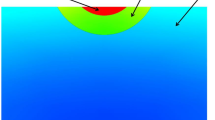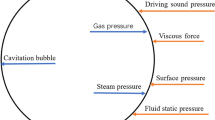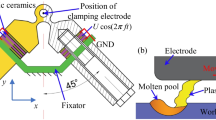Abstract
Ultrasonic vibration–assisted EDM (UEDM) has excellent performance on difficult-to-machine materials processing such as titanium alloy, stellite, and nickel-based alloy, and it was hard to describe the material removal process and surface generation mechanism due to the complex physiochemical reactions during UEDM. In the present study, the material removal mechanism is fundamentally studied based on heat transfer theory. The model of microscopic removal volume of single pulse in UEDM is established according to the characteristics of EDM removal mechanism and the interference of ultrasonic vibration energy. The micro-surface topography generating process is described and the influence of ultrasonic vibration on the machined surface is analyzed. Both simulation calculation and experiment validation are executed in order to verify the accuracy of the theoretical derivation. As the experimental results have shown, the surface-generating process is matching well with the theoretical deduction; the carbon deposit area is reduced and the surface roughness is decreased due to the ultrasonic vibration interference. The machined surface quality can be modified by adjusting the matching performance of ultrasonic vibration energy and EDM energy.






















Similar content being viewed by others
References
Wang Y, Lin B, Wang S, Cao X (2014) Study on the system matching of ultrasonic vibration assisted grinding for hard and brittle materials processing. Int J Mach Tools Manuf 77:66–73
Singh P, Yadava V, Narayan A (2018) Parametric study of ultrasonic-assisted hole sinking micro-EDM of titanium alloy. Int J Adv Manuf Technol 94:2551–2562
Abdullah A, Shabgard M, Ivanov A, Shervanyi-Tabar M (2009) Effect of ultrasonic-assisted EDM on the surface integrity of cemented tungsten carbide (WC-Co). Int J Adv Manuf Technol 41:268–280
Abdullah A, Shabgard M (2008) Effect of ultrasonic vibration of tool on electrical discharge machining of cemented tungsten carbide (WC-Co). Int J Adv Manuf Technol 38:1137–1147
Endo T, Tsujimoto T, Mitsui K (2008) Study of vibration-assisted micro-EDM—the effect of vibration on machining time and stability of discharge. Precis Eng 32:269–277
Zhang Q, Zhang L, Li J (2012) Study on electrical discharge and ultrasonic assisted mechanical combined machining of polycrystalline diamond. Diamond Abrasives Eng 6:589–593
Goiogana M, Sarasua J, Ramos J (2018) Ultrasonic assisted electrical discharge machining for high aspect ratioblind holes. Procedia CIRP 68:81–85
Ichikawa T, Natsu W (2013) Realization of micro-EDM under ultra-small discharge energy by applying ultrasonic vibration to machining fluid. Procedia CIRP 6:326–331
Che J, Zhou T, Zhu X (2016) Experimental study on horizontal ultrasonic electrical discharge machining. J Mater Process Technol 231:312–318
Klocke F, Mehnoush M, Zeis M (2018) Investigation on the variability of existing models for simulation of local temperature field during a single discharge for electrical discharge machining (EDM). Procedia Cirp 68:260–265
Yadav V, Jain V, Dixit P (2002) Thermal stresses due to electrical discharge machining. Int J Mach Tool Manu 42:877–888
Singh H (2012) Experimental study of distribution of energy during EDM process for utilization in thermal models. Int J Heat Mass Transf 55:5053–5064
Ikai T, Fujita I, Hashiguchi K (1995) Heat input for crater formation in EDM. Proceedings of International Symposium for ElectroMachining-ISEMXI. EPFL, Lausanne, Switzerland, pp 163–170
Incropera F, DeWitt D, Bergman T (2002) Fundamentals of heat and mass transfer, 5th edn. Wiley, New York
Joshi S, Pande S (2010) Thermo-physical modeling of die-sinking EDM process. J Manuf Process 12:45–56
Acknowledgments
The authors appreciate the support of Tianjin Natural Science Foundation (grant no. 18JCQNJC05200) and Tianjin Municipal Education Commission Scientific Research Project (grant no. 2018KJ116).
Author information
Authors and Affiliations
Corresponding author
Ethics declarations
Declaration of competing interest
The authors declare that they have no conflicts of interest.
Additional information
Publisher’s note
Springer Nature remains neutral with regard to jurisdictional claims in published maps and institutional affiliations.
Rights and permissions
About this article
Cite this article
Wang, Y., Liu, Z., Shi, J. et al. Analysis of material removal and surface generation mechanism of ultrasonic vibration–assisted EDM. Int J Adv Manuf Technol 110, 177–189 (2020). https://doi.org/10.1007/s00170-020-05769-x
Received:
Accepted:
Published:
Issue Date:
DOI: https://doi.org/10.1007/s00170-020-05769-x




